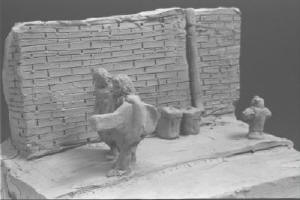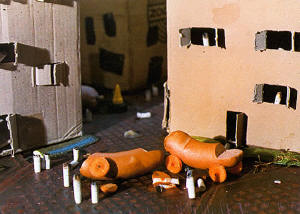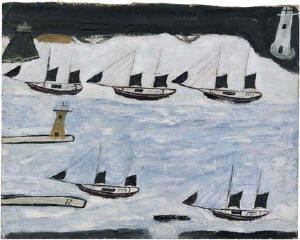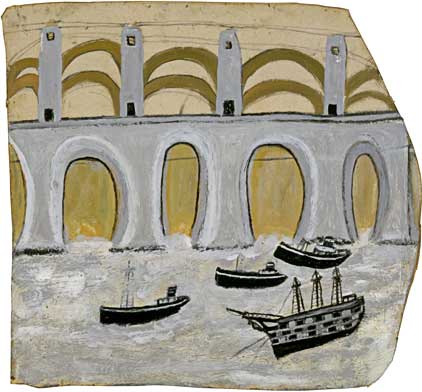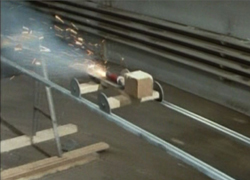| artcornwall | |||
| home | features | exhibitions | interviews | profiles | gazetteer | links | archive | forum | |||
|
Alfred Wallace, Fischli and Weiss, and measures of quality in contemporary Cornish art
Last month I went to the Fischli and Weiss show at the Tate Modern in London. Naturally I asked myself how they would go down in Cornwall, but immediately knew the answer: they wouldn’t get a show here, because their work is, apparently, so badly made. I have
written before about opposing tendencies within the large and active
visual arts community in Cornwall – characterising them as being polarised
between the modernist and the post-modern. Another way of thinking about
this is to consider the different camps in relation to the issue of The powerful lobby in favour of craftsmanship in art tend to consider that the time and care spent by the artist on the work as the thing that most confers value to it, and therefore ensures its quality. The group that are ‘pro-craft’ seek evidence of the artist’s skill in making the object, and the thing itself is often intricate and highly wrought as a result. The crafted nature of the work and in particular evidence of the artist’s skilled hand in making it are considered the hallmarks of quality, often judged in relation to the artist’s ability to render a likeness using traditional materials like oil, clay and bronze. As well as being 'life-like', in Cornwall the 'likeness' could be in relation to recognised local idioms (e.g. a painter is judged for how well they can simulate the look of a Peter Lanyon or Patrick Heron). For those that are pro-craft it is this process of labour and the artist’s skill in achieving something recognisable that gives this art its value and worth. Those that are pro-craft have an antipathy towards conceptual and minimal art, and are suspicious e.g. of photography especially where the artist appears to have put no work into taking the photograph. They are more likely to value a photographer who processes the image in such a way that it shows evidence of being ‘crafted’. The pro-crafters are also suspicious of institutions like the Tate and the Turner Prize that are viewed as elitist in promoting the more post-modern art-forms that emerged from conceptual art.
The anti-craft grouping, if I may call them that, tends to see craftsmanship as getting in the way, and would assert strongly that the search for criteria for judging art should start elsewhere. In fact many that are anti-craft would claim that the more effortless the execution of a work of art the more elegant the result, and that an artwork with too much craft risks looking over-worked and twee. This is because artists that have anti-craft tendencies tend to start with the belief that in theory anything can be art, and the challenge for the artist is in knowing what to select, or what to edit out for attention. They are guided in doing this by a knowledge of what is occurring elsewhere in the international art-community. For anti-crafters, the measure of quality thus relates not to the artist’s craftsmanship, but to the issue of whether the art appears to offer something new, different and interesting in relation to the wider movement of international art history. Much of the labour and work for the anti-craft lobby therefore involves studying other artists, going to shows out of county, especially in London and abroad, and pouring over art-journals and books. Nor does
being anti-craft mean there's no skill involved. The anti-crafters would
claim that the skill of the The anti-crafters are sympathetic to conceptual art, and to institutions such as the Turner Prize which champions post-modern and post-conceptual art-forms, but they are probably somewhat removed from the typical art-buyer or art-viewer in Cornwall, who arguably is more likely to have pro-craft tendencies. So what are the origins and implications of this hypothetical polarity? Perhaps it is generational, in the sense that those that buy from local galleries are of an older demographic that are sympathetic to the carefully-crafted. Perhaps there’s something unique about living in Cornwall: everyone is still enthralled by the modernist schools that were based here, and have not been challenged by any plausible alternative. In fact I
think it relates most strongly to how much one has studied, accepts and
buys into conventional accounts of 20th century art-history as
promoted by most institutions of higher education and galleries like the
Tate. Artists, like art-buyers and viewers, have their favourite periods
in art-history. Many in Cornwall either have a problem with the way
international art has gone in the last 30 or 40 years, or they developed
their practice many years ago and have continued
Under the circumstances it is understandable that large numbers of artists in Cornwall might fall back on traditional materials, and traditional values such as craftsmanship when making art. The problem comes when this becomes the only measure of quality, as the art then seriously risks being out-of-step with contemporary international art practices. It is likely that in Cornwall in recent years the onus on traditional craftsmanship has occurred because of a lack of persuasive opinion-makers asserting the importance of other criteria of judgement in the county. This vacuum of opinion is in contrast to the situation here in the 40s and 50s. Consider for example the founding myth of the St Ives school: Ben Nicholson championing the work of Alfred Wallace. This was the perfect example of a decisive rejection of craftsmanship and of then prevailing Victorian ideas of good technique and skill. There should be a place for all kinds of artists in Cornwall, however if art that values craftmanship above all else continues to be given so much support by local institutions (i.e. galleries, artist-societies and press), Cornwall’s influence on the map of art-history will continue to fade, and it will become more and more of a provincial back-water. It is for this reason that, in my view, it is important Cornish artists are aware of, and responsive to, that which is happening in the art-world outside Cornwall, and develop their own practice in relation to it. It is also important that there are structures in place down here that help them to do this. It should be the relation of the artist’s work to art-history that should ultimately be the truest measure of its quality. Fischli and
Wiess’ masterwork, the typically grungy-looking video ‘The Way Things Go’
(below), actually took The best art probably therefore combines both the application of skill – in the form of careful craftmanship – and a drive to be original. This latter quality – originality - can only reliably come with a knowledge and awareness of art that has been made and is being made in the wider international art-community. How can an artist know whether they are offering something new and original unless they know what other artists have done and are doing elsewhere? It is high-time in Cornwall that the balance between these two measures of quality – which Cornish art got right in the 40s and 50s - is therefore restored in favour of the latter.
RW December 2006
Why not respond to this article on the forum?
|
|||
